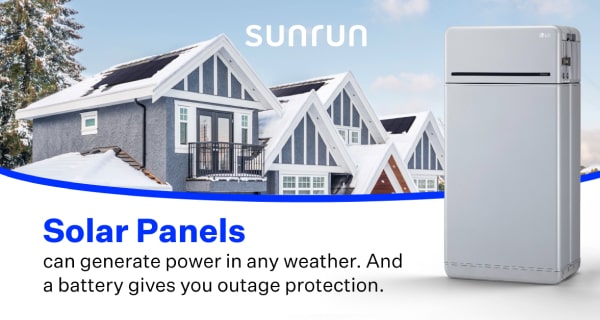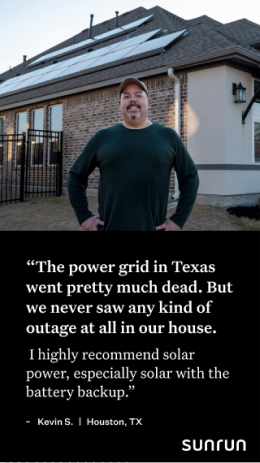Do Solar Panels Work in Cold Weather?
Sunrun Team
· 5Learn how solar panel production fares in cold weather climates.

What’s the science behind solar panels and temperature?
Even in below-freezing weather, solar panels turn sunlight into electricity. That’s because solar panels absorb energy from our sun’s abundant light, not the sun’s heat. In fact, cold climates are actually optimal for solar panel efficiency.1 So long as sunlight is hitting a solar panel, it will generate electricity. Any diminished output during the winter months will primarily be due to heavy snow and shorter daylight hours.
So, how do solar panels work? When sunlight photon particles hit solar panel photovoltaic cells, electrons in the silicon are put into motion. This creates an electric current, which is sent to your home’s electric distribution box to power your essential items.2 A rechargeable solar battery can help store this electricity so you can still use solar energy at night, during peak electricity usage, or when the grid goes down.
Remember how electrons move around atoms? Electrons are at rest (low energy) in cooler temperatures. When these electrons are activated by increasing sunlight (high energy), a greater difference in voltage is attained by a solar panel, which creates more energy. That’s why solar cells produce electricity more efficiently when it’s colder.3
In the winter, it’s also less likely for solar panels to reach their peak temperature, or peak power.4 Once their temperature rises above that peak temperature, solar panel performance decreases.
Research has demonstrated that panels begin losing efficiency around 77ºF.1 However, this diminished efficiency is balanced out thanks to more daylight hours during the spring and summer months.
Do solar panels work when it rains?
Much like Pacific Northwest winter climates, some places like Georgia, Texas, and Southern California experience a cooler rainy season.
The sun still delivers daylight to solar panels through the rain and clouds.5 Although solar panels are most productive in direct sunlight, they can still use diffuse or indirect sunlight (radiation) to generate energy.
Rainy days and clouds cause diffuse light. But what’s the difference? Direct light is solar radiation traveling in a straight line from the sun down to the earth’s surface. Diffuse light is sunlight that has been scattered by particles in the atmosphere yet still reaches the earth.6 Thus, the amount of electricity generated is dependent on the density of cloud cover.7
Though energy production decreases with increasingly dense cloud cover, panels continue working to a greater capacity than one may expect. Rain also helps wash away dust on panels to keep them operating efficiently.8
Do solar panels work in snow?
We’ve learned that solar panels thrive in colder temperatures, but what happens when it snows?
The good news is that even when covered with snow, solar panels can generate electricity.9
Sunlight still reaches solar panels through snow and keeps solar cells producing energy. Solar panels’ dark, reflective glass accelerates snow melt and it slides off before it hampers performance. Installation racks are also typically tilted up at 30 to 45 degrees, which keeps snow from accumulating (to a point).10 A light dusting of snow is likely to blow off or disappear rapidly.
In fact, on cold, clear days, snow from the ground can reflect extra sunlight onto your solar panels like a mirror. This “albedo effect” enables panels to produce even more electricity in the cold.11
Solar panels and cold weather states
Based on research across winter locations, solar is a proven economic energy solution in northern climates.12 Massachusetts and New Jersey were in the top ten states with solar installations in 2018.13 In 2019, the Solar Energy Industries Association (SEIA) ranked New York in the top ten states for solar installations.14 Solar panels are even used in Alaska and U.S. facilities like McMurdo Station in Antarctica.15
Your home doesn’t need to be in California, Arizona, or Florida to make the most out of solar. Solar panels clearly and consistently demonstrate that they can generate electricity in snow and extremely cold climates.
Power through winter storms with solar battery storage
In winter storms, the grid may not fare as well as solar panels. Power outages can be a frequent occurrence during the winter months, with some outages leaving families in the cold and in the dark for days.16 Although record numbers of Americans are staying home due to the pandemic, rising global temperatures and increasingly extreme weather events are making it much more difficult to ride out the next storm without reliable back-up power.17, 18
Installing a grid-connected, rooftop solar panel system with battery storage can give you clean, renewable back-up electricity so you can power through the next blackout. We’ve seen that solar panels are incredibly resilient in the face of extreme weather conditions. By pairing your panels with a solar battery, you can store up your sunny days for a stormy one.
The time to go solar is now
While solar panels and battery storage can be a significant investment, solar companies like Sunrun offer flexible financing options and solar plans for as little as $0 down. While solar panels can’t change the weather, they can help you ride it out.
Every winter day is a chance to power through life from the sun. Start taking control of your own energy and keep powered through extreme weather conditions. Get in touch with one of our expert Solar Advisors today.
- 1. How Does Temperature Affect Solar Panels?
- 2. How Do Solar Panels Work?
- 3. Does temperature affect the amount of energy a solar panel receives?
- 4. The Effects of Temperature on Solar Panel Power Production
- 5. What happens to solar panels when it’s cloudy or raining?
- 6. Direct, Diffuse and Reflected Radiation
- 7. Effect of cloudiness on the production of electricity by photovoltaic panels
- 8. Just a spoonful of solar panel cleaning, helps the revenue go up – the revenue go up!
- 9. Let it Snow: How Solar Panels Can Thrive in Winter Weather
- 10. Let it Snow: How Solar Panels Can Thrive in Winter Weather
- 11. Solar Panels Work Great In Snowy Regions, Research Shows
- 12. Let it Snow: How Solar Panels Can Thrive in Winter Weather
- 13. From California to Texas, these are the US states leading the way in solar
- 14. New York Solar
- 15. Drivers of solar radiation variability in the McMurdo Dry Valleys, Antarctica
- 16. Record snowfall hits parts of Midwest as storm strikes East Coast, bringing outages and downed trees
- 17. Where Americans are still staying at home the most
- 18. Incidents of extreme weather are projected to increase as a result of climate change
